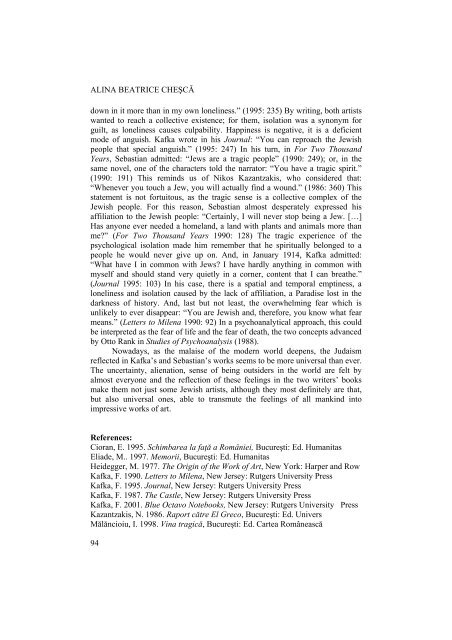culture, subculture and counterculture - Facultatea de Litere
culture, subculture and counterculture - Facultatea de Litere
culture, subculture and counterculture - Facultatea de Litere
Create successful ePaper yourself
Turn your PDF publications into a flip-book with our unique Google optimized e-Paper software.
ALINA BEATRICE CHEŞCĂ<br />
down in it more than in my own loneliness.” (1995: 235) By writing, both artists<br />
wanted to reach a collective existence; for them, isolation was a synonym for<br />
guilt, as loneliness causes culpability. Happiness is negative, it is a <strong>de</strong>ficient<br />
mo<strong>de</strong> of anguish. Kafka wrote in his Journal: “You can reproach the Jewish<br />
people that special anguish.” (1995: 247) In his turn, in For Two Thous<strong>and</strong><br />
Years, Sebastian admitted: “Jews are a tragic people” (1990: 249); or, in the<br />
same novel, one of the characters told the narrator: “You have a tragic spirit.”<br />
(1990: 191) This reminds us of Nikos Kazantzakis, who consi<strong>de</strong>red that:<br />
“Whenever you touch a Jew, you will actually find a wound.” (1986: 360) This<br />
statement is not fortuitous, as the tragic sense is a collective complex of the<br />
Jewish people. For this reason, Sebastian almost <strong>de</strong>sperately expressed his<br />
affiliation to the Jewish people: “Certainly, I will never stop being a Jew. […]<br />
Has anyone ever nee<strong>de</strong>d a homel<strong>and</strong>, a l<strong>and</strong> with plants <strong>and</strong> animals more than<br />
me?” (For Two Thous<strong>and</strong> Years 1990: 128) The tragic experience of the<br />
psychological isolation ma<strong>de</strong> him remember that he spiritually belonged to a<br />
people he would never give up on. And, in January 1914, Kafka admitted:<br />
“What have I in common with Jews? I have hardly anything in common with<br />
myself <strong>and</strong> should st<strong>and</strong> very quietly in a corner, content that I can breathe.”<br />
(Journal 1995: 103) In his case, there is a spatial <strong>and</strong> temporal emptiness, a<br />
loneliness <strong>and</strong> isolation caused by the lack of affiliation, a Paradise lost in the<br />
darkness of history. And, last but not least, the overwhelming fear which is<br />
unlikely to ever disappear: “You are Jewish <strong>and</strong>, therefore, you know what fear<br />
means.” (Letters to Milena 1990: 92) In a psychoanalytical approach, this could<br />
be interpreted as the fear of life <strong>and</strong> the fear of <strong>de</strong>ath, the two concepts advanced<br />
by Otto Rank in Studies of Psychoanalysis (1988).<br />
Nowadays, as the malaise of the mo<strong>de</strong>rn world <strong>de</strong>epens, the Judaism<br />
reflected in Kafka’s <strong>and</strong> Sebastian’s works seems to be more universal than ever.<br />
The uncertainty, alienation, sense of being outsi<strong>de</strong>rs in the world are felt by<br />
almost everyone <strong>and</strong> the reflection of these feelings in the two writers’ books<br />
make them not just some Jewish artists, although they most <strong>de</strong>finitely are that,<br />
but also universal ones, able to transmute the feelings of all mankind into<br />
impressive works of art.<br />
References:<br />
Cioran, E. 1995. Schimbarea la faţă a României, Bucureşti: Ed. Humanitas<br />
Elia<strong>de</strong>, M.. 1997. Memorii, Bucureşti: Ed. Humanitas<br />
Hei<strong>de</strong>gger, M. 1977. The Origin of the Work of Art, New York: Harper <strong>and</strong> Row<br />
Kafka, F. 1990. Letters to Milena, New Jersey: Rutgers University Press<br />
Kafka, F. 1995. Journal, New Jersey: Rutgers University Press<br />
Kafka, F. 1987. The Castle, New Jersey: Rutgers University Press<br />
Kafka, F. 2001. Blue Octavo Notebooks, New Jersey: Rutgers University Press<br />
Kazantzakis, N. 1986. Raport către El Greco, Bucureşti: Ed. Univers<br />
Mălăncioiu, I. 1998. Vina tragică, Bucureşti: Ed. Cartea Românească<br />
94












